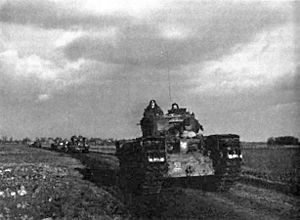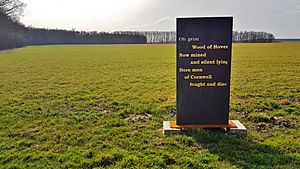Operation Clipper facts for kids
Quick facts for kids Operation Clipper |
|||||||
|---|---|---|---|---|---|---|---|
| Part of World War II | |||||||
 Column of British Churchill tanks near Geilenkirchen |
|||||||
|
|||||||
| Belligerents | |||||||
| Commanders and leaders | |||||||
| Casualties and losses | |||||||
2,000 casualties, (including 169 killed, 752 missing & 500 nonbattle) |
Unknown Unknown Unknown Unknown |
||||||
During World War II, Operation Clipper was an important battle. It took place in November 1944. British and American soldiers worked together. Their goal was to clear out a German-held area called the Geilenkirchen salient. A salient is like a bulge in the battle line. It sticks out into enemy territory. This made it hard for the Allies to move their troops. It also posed a threat to their positions.
Geilenkirchen is a town in Germany. It is located near the Wurm River. The area around it has forests, farms, and small industrial towns. Many roads and a railway line crossed the region. The Wurm River was a key natural feature. The German army had strong defenses there. These defenses were part of the Siegfried Line, also known as the Westwall.
Contents
Planning the Attack
The British and American armies decided to work together. The British had powerful artillery. They also had special tanks called "Hobart's Funnies". These tanks could clear mines or spray flames. The American 84th Infantry Division joined the British XXX Corps. This teamwork helped avoid confusion in command.
The plan had four main parts:
- First, on November 18, the U.S. 84th Division would advance. They would capture Prummern and high ground near Geilenkirchen.
- Second, the British 43rd (Wessex) Infantry Division would attack. They aimed to take high ground north and west of the town. This would almost surround Geilenkirchen.
- Third, the U.S. 84th Division would then move into Geilenkirchen itself.
- Finally, both divisions would push further northeast. They would clear areas on both sides of the Wurm River. Their final targets were villages like Hoven, Müllendorf, Würm, and Beeck.
Air support came from the RAF Second Tactical Air Force and the XXIX Tactical Air Command.
German Defenses
The German army had two main divisions defending the area. These were the 176th Infantry Division and the 183rd Volksgrenadier Division. Volksgrenadier units were often made up of less experienced soldiers. General Günther Blumentritt commanded these German forces. He had placed most of his artillery in the area.
The Germans had also laid many deep minefields. These stretched from Geilenkirchen towards Jülich. The area was where a new part of the Siegfried Line met older defenses. The Germans used strong stone buildings in villages as forts. They also built concrete bunkers.
The Attack Begins
First Moves
The attack started early on November 18. Giant searchlights, called "canal defence lights", lit up the sky. This hazy light helped mine-clearing tanks. These tanks used spinning chains, called flails, to clear mines. But the ground was wet and muddy. This made the flails less effective. So, engineers had to follow with mine detectors.
After a short artillery attack, the American 334th Infantry Regiment advanced. They easily took the high ground east of Geilenkirchen. The British attack also went well. The Worcestershire Regiment moved towards Tripsrath. They captured their first targets with little trouble. The heavy shelling before the attack had weakened the German will to fight. Also, rain had uncovered many mines. However, the rain made it hard to bring up tanks and supplies.
One British attack was pushed back by German self-propelled guns. But the Worcestershires still took Tripsrath after dark. They held most of the village, even with German soldiers nearby.
Growing Resistance
Because the first day went so well, the Allied commanders decided to speed up the plan. The U.S. 84th Division continued its advance. But a German counter-attack with tanks delayed them. This attack was fought off. Resistance in Prummern continued until November 20. British Churchill Crocodile flamethrower tanks helped clear it. These tanks were very effective. The Germans were scared of their flames.
On November 19, the Worcestershires faced more problems. They had trouble getting supplies. They also fought off a strong German counter-attack. Five British Sherman tanks arrived, but four were quickly destroyed. A second German attack, supported by heavy Tiger II tanks, was also beaten back. The Allies used anti-tank guns and other tanks.
There was a gap in the American line. This made commanders cautious. The 405th Infantry Regiment was brought in to fill this gap.
Geilenkirchen Captured
Geilenkirchen itself was captured fairly easily on November 19. The American 333rd Infantry Regiment took the town. However, the Allies had less artillery support. This was to avoid accidentally hitting their own troops. British tanks from the Sherwood Rangers Yeomanry helped a lot.
From Geilenkirchen, the advance continued northeast. They moved along the Wurm River towards Süggerath. The flamethrower tanks helped again. They cleared out German bunkers. One U.S. commander said, "A few squirts from the flame-throwers, and the Germans poured out... The bastards are afraid of those flame-throwers..."
Capturing Geilenkirchen opened a supply route to Tripsrath. German artillery heavily shelled Tripsrath for four days. But the British soldiers stayed safe in basements. The nearby village of Bauchem was captured after a very strong four-hour artillery attack. The advancing soldiers met almost no resistance there.
The American 333rd Infantry continued past Süggerath. They cleared the town during the night of November 19/20. They were still short of their final goal, Würm. But then the weather changed everything.
Rain Stops Progress
On November 21, heavy rain turned the fields into thick mud. Tanks became useless and got stuck easily. The main road to Würm was full of mines. Another road was blocked by debris. It could not be cleared until a bulldozer arrived. The American soldiers tried to advance without tanks, but they were pushed back.
When the British flamethrower tanks could finally move, they made quick progress. German defenders surrendered. But the mud stopped the tanks again. Without their support, attacks on Müllendorf failed. The German defenses there had been made stronger.
A flanking attack by the U.S. 405th Infantry Regiment also got stuck in the mud. British attacks on the other side of the Wurm River were also pushed back.
Operation Ends
Even though the last targets were not captured, Operation Clipper was a success. The dangerous Geilenkirchen salient had been mostly removed. This gave the American XIII Corps more space to move. The 84th Infantry Division returned to American command. Further attacks were stopped on November 23.
On November 23, the British Worcestershires were replaced by another unit. This was a welcome relief for them. They had faced constant shelling in their forward positions.
Images for kids




